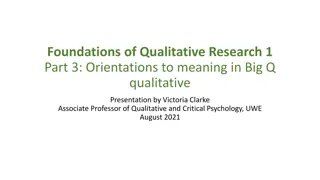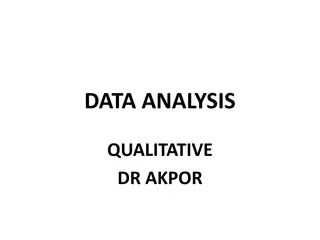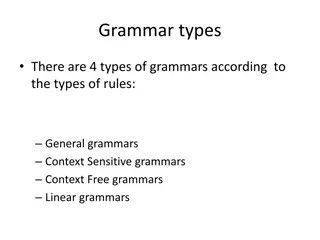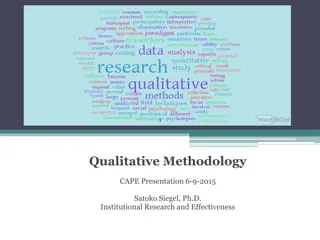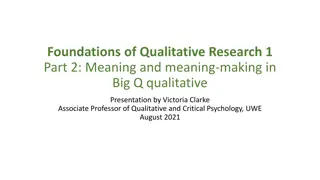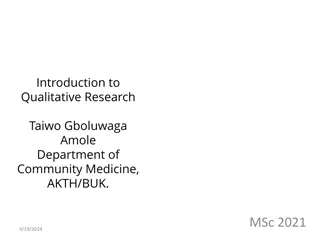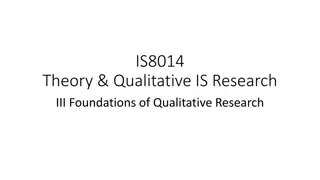Context in Qualitative Research: School of Languages Writing Classes
A study conducted at a university in Turkey focused on the writing anxiety of EFL students in an English writing class setting. The study explored the impact of peer feedback on students' perceptions and anxiety levels, highlighting the importance of feedback in improving writing skills.
Download Presentation

Please find below an Image/Link to download the presentation.
The content on the website is provided AS IS for your information and personal use only. It may not be sold, licensed, or shared on other websites without obtaining consent from the author.If you encounter any issues during the download, it is possible that the publisher has removed the file from their server.
You are allowed to download the files provided on this website for personal or commercial use, subject to the condition that they are used lawfully. All files are the property of their respective owners.
The content on the website is provided AS IS for your information and personal use only. It may not be sold, licensed, or shared on other websites without obtaining consent from the author.
E N D
Presentation Transcript
WritingMethodology Section (Qualitative Research)
COMPONENTS Context of theStudy Research Design Participants Instruments Data Analysis Procedureof theStudy Trustworthiness
Context of theStudy Write where the study tookplace Give as manydetails as possible aboutthe setting This is not the participants section, sowhile giving info, focuson the whole population in this setting, not your participants
Context of theStudy: A sample takenfrom nar, G. (2014). TheeEfectof Peer Feedback on EFL Students WritingAnxietyandtheirPerceptionsabout theUse of Peer Feedback in WritingClasses. (UnpublishedM.A. Thesis). a University, Mersin. The study was carried out at the School of Foreign Languages, in a universityin Turkey. The School of Foreign Languages has four levels ranging from A to D and levels A, B, C, and D as elementary, pre-intermediate, intermediate, and upper- intermediate in order. In each level, 5 hours is spared to teach writing skills in English to students because the school gives importance to writing. There are at least 17 students in a writing class, and these students have to write a paragraph or essay depending on their levels. They prepare the first draft of their paragraphs or essays, get feedback from their writing teachers, and write the second (final) draft of their paragraphs or essays. In addition, a writing teacher is assigned to teach two writing classes and is supposed to check their students first drafts, give feedback to them, re-check and evaluate the second drafts of their students writings. In accordance with the teaching context, the researcher observed that this process leads to work overload for teachers and to dependence on teachers feedback for students in writing classes, which causes some students to display fear in writing classes.
ResearchDesign Identify thestrategy of inquiry youhaveused: Descriptive (describing thecharacteristics of thepopulation) Ethnography(studyingothersin their ownculture) case study(in-depthunderstanding of a single case) Phenomenology(understandinga uniqueaspectof humanphenomena) Biography(understandinga person in his/her context) Describethe characteristicof the design, citingsources when needed.
ResearchDesign: A sample takenfrom Onwuegbuzie, A. J. andLeech, N. L. (2010). Generalizationpracticesin qualitativeresearch: a mixedmethods case study. QualQuant, 44, 881-892. Using LeechandOnwuegbuzie s(2005) framework, themixedmethodsresearch design representeda fullymixedsequentialdominant statusdesign . Thequalitativephaseinvolved a case study. Specifically, a two-levelcase study wasutilized. The firstlevel, involving choice of thejournalrepresented an instrumentalcase design. According toStake(2005), in instrumentalcase designs, a particular caseis examinedprimarily toprovide insightsintoan issue suchthatthecase is of secondaryinterest, playingsupportiverole. Inthis investigation, it wasexpectedthatthecase wouldfacilitate understandingof the generalization practices of some qualitativeresearchers. Thesecond level, invovingtheselected empirical articles representeda multiple or collective case design, whichis an intstrumentalcasedesign thatis extendedtoseveral cases (Stake, 2005) andwhichfacilitates cross-case analyses.
Participants Write who yourparticipantsare Give info aboutthe sampling method that you used, giving details aboutsampling procedures (purposive, opportunistic, volunteer, ) Give demographic information such as age, gender, Write how yougot permission from the participants and/orthe administration: mention the consent form here andattach it at the end as attachment
Participants: A sample takenfrom nar,, G. (2014). TheeEfectof Peer Feedback on EFL Students WritingAnxietyandtheirPerceptionsabout theUse of Peer Feedback in WritingClasses. (UnpublishedM.A. Thesis). a University, Mersin. Although the number of the participants in this study was expected to be 18, two of them did not want to participate in the study. Thus, the total number of the participants was decreased to 16, eleven of whom were female students and five of whom were male students. The participants were students at one of the English preparatory department of a university in Turkey. Their level of English was intermediate, which was determined by a placement and proficiency exam organized and done by the Testing Office of the department. These students were in their first term and took courses such as Reading and Writing, Listening and Speaking, Expansive Reading, Applied Linguistic Skills in which group work is expected to apply excessively, and lab classes. The students were selected by taking into account the fact that they were the-would-be doctors who are going to need English throughout their career pathway.
Instruments Givedetailed informationabouteachinstrument you haveused: Ifyouhaveusedan alreadyexisting instrument, write whereyougotit from andwhyyouusedit Ifyouhaveadapted an alreadyexistinginstrument, write whereyougotit from and whyyouhaveadaptedit. Giveyourjustification foradaptationand presentcredibility Ifyouhavedevelopedyourown instrument, giveallthedetails of the processof developmentandpresentitscredibility Inallsituations, givethe instrumentin theAppendixsection
Instruments: A sample takenfrom nar,, G. (2014). TheeEfectof Peer Feedback on EFL Students WritingAnxietyandtheirPerceptionsabout theUse of Peer Feedback in WritingClasses. (UnpublishedM.A. Thesis). a University, Mersin. 3.3. Data Collection Instruments In order to collect data, qualitative and quantitative data collection tools were used. For qualitative data collection, two interviews and teacher diary were used. For quantitative data collection, Second Language Writing Anxiety Inventory (SLWAI) was used. They were explained in detail in this section. 3.3.2. Interview In order to supplement the results of SLWAI, interviews were made before and after conducting study (see Appendix 3). The interview had four questions dealing with what students thought about the effects of peer feedback on their writing anxiety, whether peer feedback increased their self-confidence in writing, whether they liked it or not, and what they felt about giving and taking peer feedback.
Data Analysis Be careful! This is not the sectionwhere youpresent the findings of youranalysis Write how youanalyzed yourdata; what techniques you used, andhow youusedthem
Data Analysis: A sample takenfrom nar,, G. (2014). TheeEfectof Peer Feedback on EFL Students WritingAnxietyandtheirPerceptionsabout theUse of Peer Feedback in WritingClasses. (UnpublishedM.A. Thesis). a University, Mersin The interviews were made with all students at the beginning and the end of the study to find out the attitudes of the students towards peer feedback. Also, teacher diary was kept to discover what worked and what did not work and to share and reflect the researcher s experience with the research based on her observations and talks with the students. The interviews were content analyzed while teacher diary was narrated. The recorded data from each interviewee in the form of sentences were transformed into findings by identifying, coding, and categorizing by the researcher herself and another researcher who carries out quantitative studies in the field and is familiar with content analysis (Patton, 2002; Creswell, 2007). Besides this, teacher dairy was re-storied chronologically because restoryingis used to frame a story according to time, scene, place or plot in a chronological order in order to make narrative analysis of the story (Creswell, 2007). In order to validate the qualitative results of the research, triangulation and the participation of another researcher into data analysis process were used (Creswell, 2007).
Procedure of theStudy(if necessary) Write all yoursteps oneby one(like a recipe book) Ifsomeoneelse wants to replicate yourstudy, s/he shoud do it reading this section without asking anyfurther questions toyou
Procedure of theStudy: A sample takenfrom nar,, G. (2014). TheeEfectof Peer Feedback on EFL Students WritingAnxietyandtheirPerceptionsabout theUse of Peer Feedback in WritingClasses. (UnpublishedM.A. Thesis). a University, Mersin 3.4. Procedure of theStudy This study was carried out at the English Preparation Department of the School of Foreign Languages, XX University in Turkey. It lasted 7 weeks. A training session about peer feedback was organized in the first two weeks. During the following weeks, the students studied peer feedback with 5 writing assignments in class. Therefore, the data collection procedure was organized as the training period and the implementation procedure. 3.4.1. The Training Period Prior to starting the study, the advantages of peer feedback based on the literature were explained to the students and they were encouraged to attend the study. The researcher also encouraged students to work in collaboration. The researcher gave the students training along with some guidelines like identifying content, organization, grammar, and so on for two weeks to help them deal with these during the process of peer feedback. By doing this, the researcher guided the students on how to give and receive feedback on their writing
Trustworthiness Qualitative researchis subjective, sothe mostimportant thing is torespondtothe concernsof outsiders. Think of these questions: Towhatextent can we placeconfidencein theoutcomes of the study? Do the readers believe whatwe havereported?
How can weachievetrustworthinessin qualitative studies? Guba s(1981) fourcriteria: A) Credibility (instead of internal validity) B) Transferability (instead of external validity / generalizability) C) Dependability (instead of reliability) D) Confirmability (instead of objectivity)
1-CREDIBILITY Ensuring that the study is measuring or testingwhat is actually intended (as in internal validity) How can we ensure this? 1. Well-establishedadoption of research methods: Derive the specific procedures employed (data gathering and the methods of dataanalysis)from those that have been successfully utilised in previous comparable projects.
2. Triangulation Mainly 4 types of triangulation (Denzin, 1984) a. Data source triangulation: observing data in different context (time, space, persons) b. Investigator triangulation: multiple researchers in an investigation c. Theory triangulation: using more than one theory in the interpretation of the data (e.g. having investigators with different points of views interpret the same data) d. Methodological triangulation: using more than one method to gather data (e.g. interviews, observations, questionnaires, documents)
3. Co-operation Create opportunities for scrutiny of the projectby colleagues, peers and academics get feedbackat presentations (e.g. at conferences) that are given over the duration of the project.
4. member check (Lincoln andGuba, 1985) The process of asking research participants totell you whether youhave accurately described their experience. Checks may take place on the spot in the course, and at the end of the data collection dialogues. Participants may also be asked to read any transcripts of dialogues in which they have participated to check whether the participants consider that their words match withwhat they actually intended. Another element of member checking should involve verification of the researcher s emerging theories and inferences . Where appropriate, participants may be asked if they can offer reasons for particular patterns observed by the researcher.
2-TRANSFERABILITY (Generalizability) The extent to which the findings of one study can be applied to other situations (as in external validity) Qualitative studies do not aim togeneralize the findings, Transferability is important: If other researchers believe their situations to be similar to that described in the study, they may relate the findings to their own positions, sogive the Context of theStudy in detail.
3-DEPENDABILITY (Reliability) Reliability: If the work wasrepeated in the same context, with the same methods andwith the same participants, wouldsimilar results be obtained? ForLincoln and Gubathere is a close tie between credibility and dependability:a demonstration of the credibility demonstrates its reliability Thus, giveclear anddetailedinfoaboutthe study (thickdescription) The purpose of the study The sampling andsetting (context of the study) Data collection andanalysis procedure Findings/outcomes
4-CONFIRMABILITY (Objectivity) Ensuring as far as possible that the work s findings arethe result of the experiences and ideas of the participants, rather than the characteristics and preferences of the researcher. Thus, detailed methodological description is needed





